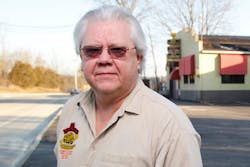Bob Williams watched the town slowly change. As the construction crews began tearing up Hwy. 83 in downtown Genesee, Wis., local businesses started closing.
Store after store along the rural Wisconsin mainstreet went out of business, and the three-year construction project was slowly creeping toward his shop, S&S Research, in nearby Mukwonago.
Hwy. 83 was the lifeblood of Williams’ business. The easy access and high visibility had helped his shop thrive for more than 30 years in the same location. But the state highway was the only way in or out, and the construction was slated to last from March through Thanksgiving of 2010. The road would be completely torn up, making it extremely difficult—yet, still possible—for customers to get to Williams’ shop.
“I’d seen that so many of those businesses went out of business because they weren’t prepared for the construction,” Williams, 59, says. “I wanted to try to take every avenue that I could to come out ahead to make it through that construction.”
Williams would try to save his business with a plan focused on one simple piece of paper: a map.
The Backstory
Since he bought the space in 1977, Williams’ facility has sat on the corner of Hwy. 83 and Old Village Road, seven miles south of Interstate 94 and seven miles north of Interstate 43. S&S Research is less than a mile from downtown Genesee, and about 20 miles west of Milwaukee.
A bodyman by trade, Williams operated as a two-person collision shop for six years, before deciding to add on a mechanical segment in 1983.
After an expansion later in the 1980s and a rebuild in the late 1990s, Williams has 18,800 square feet of space over two buildings, 8,000 of which is dedicated for collision repair.
In 2009, the 12-employee, $2.2 million business did just above $1.1 million in collision work.
The Problem
In all, the Wisconsin Department of Transportation planned to widen a 17-mile stretch of Hwy. 83 in three separate phases. The first would take the construction across Williams’ parking lot entrance.
There would be a detour in place, and there would be times when the stretch of highway in front of the shop would be completely closed.
Certainly, Williams says, the construction would all but eliminate the shop’s opportunity for drive-by customers (despite being a rural area, the fact that Hwy. 83 connects two major interstates meant plenty of walk-in work for the shop).
This had the potential to decimate his mechanical business, and to put a huge dent in the collision side as well. He has little focus on direct repair work, and had a steady stream of work that came from outside his small town. He also had a number of fleet accounts with local and regional companies that kept the body shop humming even in slower, good-weather seasons like the summer.
Williams had his concerns: Would those customers be willing to navigate the detours? Would they even realize he was still open? Would it be that much easier for them to simply go to a competitor?
The construction was only supposed to last a few months, just the summer, but timetables on projects like that are often extended. The business was sound enough to sustain a small lapse over a short period, but Williams didn’t want to leave anything to chance.
“I took this very seriously,” he says of the threat to his business. “I was going to take charge of the situation. … [Not being prepared] would’ve scared the heck out of me, just not doing anything and not trying to take charge of the situation.”
The Solution
It was still October of 2009 when Williams began brainstorming, a good five months before the first bulldozer came around.
And Williams came to a simple conclusion. Customers would still be able to come to his shop, if willing, and his shop could still perform all necessary work without any exceptions. The construction would have virtually no effect on the shop’s actual operations.
So, there would be two things that would keep them from coming in: knowledge of the situation (whether the shop was closed, whether it was fully operational, how to avoid the construction, etc.) and the inconvenience of the detours.
He needed a solution that would cover both of those issues.
Williams had worked with small business marketing firm Automated Marketing Group (AMG) for several years. They built his shop’s website and helped him manage special marketing projects. Williams had a concept he wanted to try out, and turned to AMG’s Will Johnson for some help.
“The biggest thing was information,” Johnson says. “The newspapers would have things like when the construction starts or how long it would go or the different phases. But they weren’t updating people.
EXPERT TAKEInteractive MarketingBob Williams was able to take full advantage of a difficult situation, says Danny Sanchez of Autoshop Solutions. But, as Sanchez explains, you don’t need a potential catastrophe to engage people through your online marketing. The first thing is to change your definition of “social media.” It’s not just Facebook, Twitter, and the rest; your website is now a social media platform. It can’t just be a landing page or a directory for people to find you anymore. That’s still at the core of it all, but for search engine optimization (SEO) and to stay relevant to customers, you need to use your website as a tool to engage people in a social way. And it’s simple to do:Step 1: Choose a topic or a cause. There are things happening in every community, whether it’s a group or a cause that you’re involved in or an event—like Williams’ road construction. Own that cause, become a source for it. It’s simple to add platforms to a website or a blog page that you can do this on. But make sure it’s something relevant and that others will care about.Step 2: Use other tools to get people engaged. Take advantage of your other outlets, like Facebook or Twitter or other marketing efforts, to bring attention to this information. Direct people to it and demonstrate how the information is current and important.Step 3: Carry it through. For this to work, you have to keep at it. You can’t put up a post, and then stop. You can’t do it for a month, and then quit on it. You have to build it up, and people need to see that you’re committed to doing this.
“We wanted to make it very simple to get this information, and we wanted people to get it from S&S Research.”
Williams and Johnson started with just one simple concept. Using Google Maps, Williams created detour directions to his facility—a clear, concise, one-page description for anyone looking to get to his shop. He kept a digital copy and printed out roughly 5,000. The entire marketing plan would be created around this map.
The Plan
The idea, Williams says, was to flood his community with the maps, because not only did they serve as a piece of advertising, but they also informed the people in the area of how to avoid the construction; with only one main thoroughfare in the area, people would use the detour for a number of reasons beyond just going to his shop.)
Williams and Johnson worked to integrate the maps, directions and construction information into every facet of the business’s marketing they could.
Website. Johnson and the AMG team created a new tab on the shop’s website and embedded the interactive, digital version of the map. It also turned that page into a blog of sorts, updating daily with news of the construction. The information was either gathered through the Wisconsin DOT or through Williams’ observations. The goal, Johnson says, was to have his website become the best source of info on the construction in the area.Social Media. The map was also put on the shop’s Facebook page, and Williams made daily updates with photos and news of the construction. He took hundreds of photos, updating the community through daily visuals of the construction. Also, to keep people engaged with his Facebook page, Williams began doing “Facebook Fan of the Month” giveaways, handing out $50 gift cards to a variety of retailers and restaurants.Phone Answering. The first thing Williams did with the maps was to tape one to each of his shop’s phones. Every time a customer called, his staff was directed to inform them of the upcoming or current construction conditions and provide them with detailed directions of the detour to the shop.On-Hold Message. Williams had a local radio announcer record an on-hold message for the shop, detailing the construction plans, the road closure and describing the detour route.Convenient Drop Off and Pickup. For customers uneager to navigate the detour (even some fleet accounts), S&S Research began pushing their existing shuttle service and suggesting night dropoffs to avoid any possible traffic delays caused by the construction. Williams and his staff also began to do more pickup and drop off for customers.‘Dear Neighbor Letters.’ Through AMG, Williams turned his regular direct mail pieces into information updates. Each one, whether it was an appointment reminder or a thank-you letter for past services, had a printed map attached to it.Invoices. Every document that left the shop with a customer had a map stapled to it, Williams says, including each invoice.E-Newsletter. AMG already produced a monthly newsletter for Williams’ shop, and prior to and during the construction, it added in the latest construction updates, some photos and the map.Specials. Williams negotiated with his vendors to adjust pricing on certain items, and he then passed those savings on to his customers in the form of discounts. Whether it was paint, detailing products or smaller parts, Williams would run specials relating to those jobs. He also offered discounts to anyone working on the construction crew, something that provided him with additional work. They’d fix mirrors, dents or even full body panels while the construction employees worked.The Aftermath
The construction ended around Thanksgiving, Williams says, some nine months after it first started. Yet, in 2010, revenue grew by 6 percent at S&S Research.
“Not only did Bob’s shop survive, but he maintained everything he had before,” Johnson says.
The shop’s web traffic shot up dramatically as well, by roughly 40 percent. And 70–80 percent of visitors clicked on the shop’s construction-update tab. The shop was also in the first page of Google searches for “Highway 83 construction,” Johnson says, and the shop quickly surpassed 200 likes on Facebook.
The construction is long gone from Williams’ shop, but he still updates customers through his various marketing pieces of the how they could be affected in the construction’s second phase.
Ignoring the regular fee that Williams pays AMG, many of the things he did were cost free. Any shop can add pages to their site, update a blog or social media, and work to inform customers without spending a dime, he says. The only additional costs added to his regular marketing budget was the extra printouts of the maps.
The Takeaway
Williams feels the biggest reason his shop was able to come through this situation successfully was because of the proactive approach. He didn’t wait until the construction began to take its toll before he did anything about it.
“We were really able to get out ahead of it,” he says. “The number one thing is to make sure your name is always out there. Never stop marketing. And we’re doing it in a way that can help the people in our community. A very good way of promoting [your business] is to build that strong community tie.”





